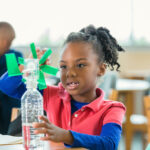Last Modified: February 16, 2023 | Published: January 31, 2023
How anxiety in childhood presents
Anxious children tend to look scared a lot. They may often make comments, such as, “what if,” because they fear something terrible happening during future events. These kids often fear many things. You may notice intense fear of dogs, insects, or the dark.
They may be very nervous around people and may avoid social events. They often avoid being the center of attention and get very anxious if people look at them too long. Children with anxiety often have trouble sleeping.
Symptoms you may notice
- Physical symptoms: your child may have tummy aches and headaches that have no apparent health origin
- Not able to focus: your child may get so nervous that they cannot concentrate at school. It may appear that your child has ADHD or an attention problem. They are too worried to stay on-task for very long
- Overwhelmed by excess stimuli: your child may be easily overwhelmed by loud sounds or bright lights
- Behavioral tics: your child may have what appears to be uncontrollable movements such as eye blinking, grimacing, or head nods
- Catastrophizing thoughts: your child is always predicting the worst-case scenario
- Little problems feel like big problems: your child’s worry creates everything to feel like a big problem
- Compulsions: your child may engage in repetitive behaviors that are used to bring down anxiety
Four common types of anxiety in children and teens
Generalized anxiety
Significant worry more days than not about various topics or situations. Your child may be restless and irritable and have trouble focusing and concentrating. In addition, you may notice challenges with sleep. The worry is not better explained by a specific type of worry (like social anxiety), and another mental health condition does not explain it.
Separation anxiety
Your child or teen has significant difficulty separating from a primary caregiver. Your child may have nightmares and physical symptoms like bedwetting. Your child may fear sleeping alone or refuse certain daily activities. Your child may avoid going to school or a friend’s house because you will not be there. Your child may have a fear something terrible could happen to you. This form of anxiety could develop after a stressful event or situation. Such as a hospital stay or an unexpected parental illness. Other times, parent challenges, such as parents separating, can impact the child. This type of anxiety is most common in children ages 7 to 11.
Social anxiety
Your child or teen may have a fear of social situations. They are afraid of being judged or embarrassed. You may notice it leads to avoidance of social settings. When your child is expected to participate in a social activity, you may notice a sudden onset of somatic symptoms. This is common in adolescence and adulthood.
Specific phobia
Your child has a specific worry that is overwhelming and lasting. The most common phobias in children include the dark, animals (often dogs), and inclement weather (like storms). Fears of heights or medical procedures are also common.
Interventions to help anxious children
Cognitive-behavioral therapy with the use of exposure and response prevention
For phobias, CBT is often paired with exposure therapy. Your child is slowly exposed to the stimuli causing fear. If you want to learn more about how to help your child face their fears, try our Cadey course on anxiety in children.
Increase emotional awareness
With your child, help them recognize their feelings and where they are in their body. Try things such as drawing emotional faces and acting out different emotions. Journaling about emotions is also shown to be effective.
Improve coping skills
Help your child identify and practice coping skills. For example, try belly breathing, progressive muscle relaxation, walking, and jumping on a trampoline.
Work to improve self-confidence
It may help to look at your child’s thinking. Look at the thoughts that are causing your child distress. Are these thoughts true and accurate? Would a different, more relevant thought be helpful?
Mindfulness
Mindfulness is being aware of the present moment. For example, it often recognizes in this moment I am safe, loved, and supported. With anxiety, we often get the case of what ifs. Mindfulness is focusing on what is happening right now.
Would you like help for your child now? At Cadey, we have a course about how to help your child with anxiety where you will learn tools to support your child.
Where to go for help
Here at Cadey, we are on a mission to get families the help they need today. You can learn the strategies you would be given in a therapist’s office in just minutes a day.
Outcomes of treatment
Anxiety is a common diagnosis and is treatable. Engage in evidence-based treatment as early as possible. With early intervention, it is possible to see significant improvement.


